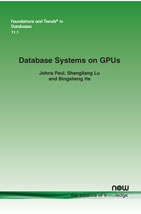Database Systems on GPUs
By Johns Paul, NUS, Singapore | Shengliang Lu, NUS, Singapore | Bingsheng He, NUS, Singapore, hebs@comp.nus.edu.sg
Abstract
This article gives an overview of history and recent developments in database systems on graphics processing units (GPUs). GPU, which was originally designed as a co-processor for rendering and graphics, has become a powerful, programmable, many-core processor in the past decade. As the GPU achieves much higher computation power and memory bandwidth than the CPU, GPU accelerations become an effective means to improve the performance of main memory databases. Database systems on GPUs have their root designs on traditional database systems on the CPU, but many GPU-optimized system designs have been introduced, ranging from data layouts, operator design to query processing and query optimizations. Those designs can achieve significant performance improvements over the traditional designs. In this article, we start with introducing the background on GPU as a parallel architecture and the traditional parallel query processing in main memory databases. Next, we present the details of GPU-optimized system designs. We then survey a series of commercial and research systems, and outline the research trends. We wrote this article as an introductory article in GPU-optimized database systems especially in online analytical processing (OLAP), which can be used as a short text for graduate level or a survey for researchers. We emphasize on the breadth and try to cover as many publications (such as those published in ACM/IEEE) as possible, with necessary details in some key GPU-optimized designs.
Database Systems on GPUs
In recent years, the growth of the amount of data required to be analyzed by computing systems has outstripped the performance of the hardware CPUs, resulting in the hardware becoming a potential bottleneck. The Graphical Processing Units (GPU), however, has become a powerful, programmable, many-core processor in the past decade that turns out to be an effective means to improve the performance of main memory databases.
In this monograph, the authors provide background on GPU as a parallel architecture and the traditional parallel query processing in main memory databases. GPU-optimized system designs are then covered before surveying a series of commercial and research systems.
Database Systems on GPUs provides a thorough introduction to GPU optimized database systems especially in online analytical processing (OLAP). It can be used as a short text for graduate level students or a survey for researchers. The authors emphasis is on the breadth of the subject and cover as many publications as possible, with necessary details in some key GPU-optimized designs.
